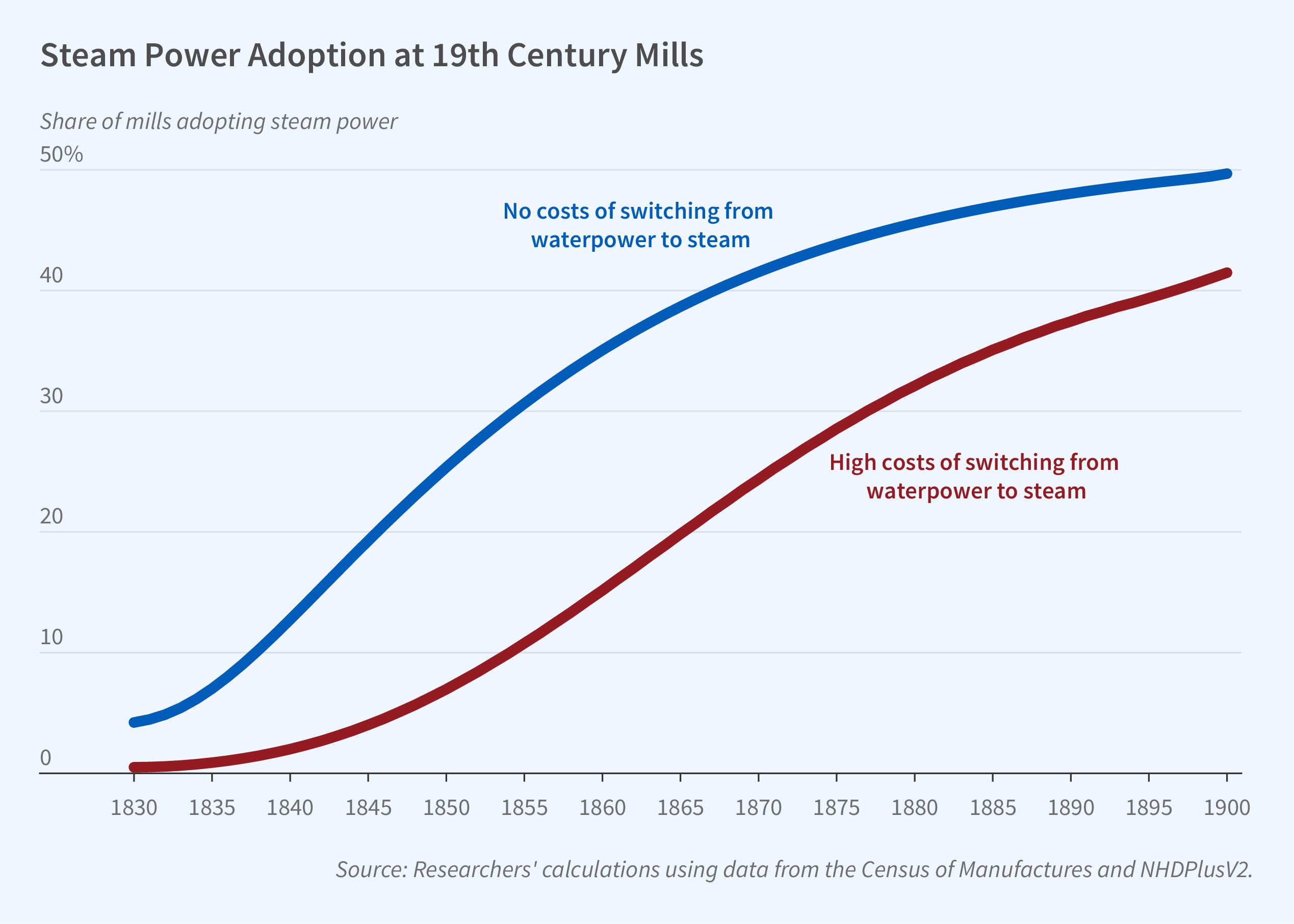Gaining Steam: Incumbent Lock-In and Entrant Leapfrogging

Water mills were the predominant power sources in the US in the early nineteenth century. The introduction of improved steam engines around 1850 offered a viable alternative. Steam power was less expensive for scaling up production and offered consistent year-round access, but it was costly to install and required continual maintenance. There were also substantial barriers to switching from waterpower, including retrofitting costs and scrappage. In Gaining Steam: Incumbent Lock-In and Entrant Leapfrogging (NBER Working Paper 32384), Richard Hornbeck, Shanon Hsuan-Ming Hsu, Anders Humlum, and Martin Rotemberg document how switching barriers slowed down the technological transition from waterpower to steam.
Steam power was particularly useful in locations where waterpower would have required building expensive dams, millponds, and river walls, or involved high costs for securing water rights. The researchers estimate the waterpower potential of a county using data on the flow rate and fall height of water from the National Hydrography Dataset Plus (NHDPlusV2). They obtain data on mills and other manufacturing establishments spanning the years 1850 to 1880 from the Census of Manufactures.
When steam power became widely available, many firms that initially adopted waterpower faced substantial switching costs that slowed adoption of the new technology.
A one standard deviation decline in a county’s waterpower potential was associated with 65 percent fewer water-powered mills, 68 percent less water-powered revenue, a 9 percentage point higher share of steam-powered mills, and a 12 percentage point higher share of revenues produced using steam power in 1850. The share of mills using steam power grew 6.7 percentage points more between 1850 and 1860 in counties with lower waterpower potential and 3.4 percentage points more in the subsequent decade. The growth disparity between 1870 and 1880 was statistically insignificant, as places with more waterpower potential also began to adopt steam more in later periods.
Counties with one standard deviation less waterpower potential also had 25 percent more growth in the number of mills overall and a 20 percent greater increase in total revenue. This growth was driven by entrant firms: lower waterpower potential counties had 38 percent higher firm entry rates and 21 percent lower survival rates than high waterpower potential counties as local incumbent firms were driven out. Entrants were four times more likely to use steam power than incumbents.
These differences affected other manufacturing activity. In 1850, counties with lower waterpower potential had substantially less non-mill manufacturing activity, and those activities were also more likely to use steam power. Steam implementation in mills required building a local knowledge base and encouraged local manufacturing of steam equipment, leading others to adopt steam technologies.
The researchers estimate a structural model to understand the influence on steam adoption decisions of different initial costs of adopting waterpower versus steam power, costs of switching from water to steam, and falling steam prices over time. They conclude that in the absence of switching barriers, the steam adoption rate would have hit 30 percent more than two decades earlier than it did. Although many incumbents exited, many low-productivity incumbents stayed with waterpower even as they scaled up. The researchers also estimate that if governments had subsidized steam adoption by purchasing old waterpower infrastructure, they could have counteracted technological lock-in, promoted agglomeration effects, lowered goods prices, and raised profits for existing firms.
—Whitney Zhang
This research was funded in part by the Initiative on Global Markets at the University of Chicago Booth School of Business, the Neubauer Family Assistant Professors Program at the University of Chicago, and the NBER Innovation Policy grant program. This material is based upon work supported by the National Science Foundation under Grant Number SES-1757050/1757051.


